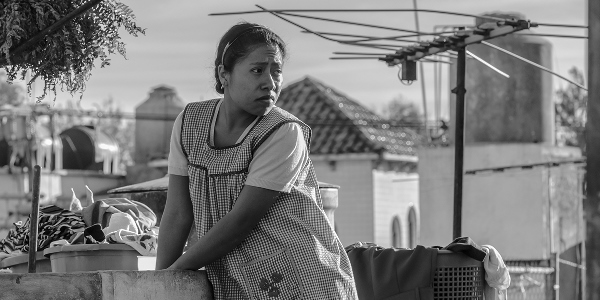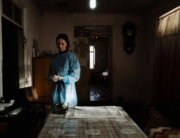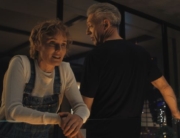![]() What is the best way to see writer/director Alfonso Cuarón’s reportedly semi-autobiographical ROMA? Definitely on the big screen, for which this gleamingly beautiful-looking film was exclusively designed. Shot in luminous black-and-white in 65mm, virtually every shot has a richness of depth. However, much of the film’s visual vitality will be lost on a smaller screen. It also has its own unforced, steady rhythm that becomes more absorbing hour by hour—it’s 135 minutes long—so much so that it’s one of the fastest-moving movies set at a tardo pace. (Still, there was a lot of fidgeting among viewers both times I saw the film.) After winning the Golden Lion at the Venice Film Festival, the movie was the runner-up to Green Book for the Toronto International Film Festival’s Grolsch People’s Choice Award, out of the 255 films under consideration.
What is the best way to see writer/director Alfonso Cuarón’s reportedly semi-autobiographical ROMA? Definitely on the big screen, for which this gleamingly beautiful-looking film was exclusively designed. Shot in luminous black-and-white in 65mm, virtually every shot has a richness of depth. However, much of the film’s visual vitality will be lost on a smaller screen. It also has its own unforced, steady rhythm that becomes more absorbing hour by hour—it’s 135 minutes long—so much so that it’s one of the fastest-moving movies set at a tardo pace. (Still, there was a lot of fidgeting among viewers both times I saw the film.) After winning the Golden Lion at the Venice Film Festival, the movie was the runner-up to Green Book for the Toronto International Film Festival’s Grolsch People’s Choice Award, out of the 255 films under consideration.
More times than not, Cuarón’s camera glides through the upper-middle-class household of a white Mexican family in Mexico City’s Roma district, circa 1970. The three domestics are of indigenous backgrounds: Cleo (Yalitza Aparicio, in her debut) is the maid and Adela (Nancy García) the cook; the family also has a driver. Cleo’s always the first one up and the last to bed, and when she retires to the room she shares with Adela, she does so by candlelight so as not to waste electricity. Dr. Antonio, the head of the family, remains mostly an off-screen presence given that this household, and the film, is run by women, including Sofía (Marina de Tavira), his wife and mother of their four kids.
Cleo is practically one of the family, as more than once she tells the children that she loves them, and the kids return her affections, expressing their feelings for her more often than they do for their own mother. When Cleo watches a Mexican sitcom with the family, one of the boys drapes his arm across her shoulder, although he’s sitting on the coach and she kneels on the floor. Later on, Sofía takes Cleo on a vacation with the kids. Friction only ignites when the patriarch chides his wife for the disheveled household and the copious dog droppings in the driveway—apparently, dog walking is not part of anyone’s regimen.
Cuarón fills this memory piece with incidents that disrupt the everyday routine: Cleo experiences an earthquake while visiting a hospital nursery. She also overhears a conversation that finally reveals why Dr. Antonio has yet to return from his business trip in Canada, and political strife often penetrates the narrative—specifically the Corpus Christi Massacre of 1971.
Cuarón also served as the director of photography (as well as co-editor), and his camera takes in everything. Even when it stands still, the ongoing sequences become mesmerizing, built around striking images, all connected, though loosely, to the lithe story line: corps of young men all striking the same pose during martial arts training or a nighttime scene in which onlookers sip champagne while others put out a brush fire.
When ROMA is viewed in theaters, Cuarón is definitely in control. However, watching this at home or during a commute would surely alter the experience. Because of its pace, the movie may face a challenge grabbing and holding viewers if distractions vie for their attention, beginning with first shot: a long take squarely focused on a patch of floor tiles. During this opening credit sequence, soapy water splashes across the surface. When it becomes still, a skylight is reflected on the surface, and through this reflection, we see a jet plane flying across the sky, a detail that might be lost or minimized on a cell phone.
During the festival, actress Viola Davis gave an interview in the New York Times and mentioned she regretted taking the role of a domestic worker in The Help, a 2011 drama set in the 1960s segregated South: “I just felt that at the end of the day that it wasn’t the voices of the maids that were heard.” Davis went on to say, “And I know that if you do a movie where the whole premise is, I want to know what it feels like to work for white people and to bring up children in 1963, I want to hear how you really feel about it. I never heard that in the course of the movie.”
Cuarón’s film doesn’t have exactly the same problem as The Help. He builds his narrative entirely around Cleo. She’s in every scene, or nearby at least, and the audience certainly knows what she feels and thinks, albeit with limits. However, she doesn’t have a life outside of the household, except for a few dates at the movies with the cousin of Adela’s boyfriend. Ultimately, the film becomes more concerned with her place within the confines of her employer’s home. All narrative threads lead to the family.
As written and portrayed, the patient and obedient Cleo is placid; it seems unlikely she would ever demand a raise. Knowing her place, she reacts calmly, even when the unruly kids run down a downtown street out of her sight—their roughhousing would give The Sound of Music’s Maria pause. In the end, Cuarón depicts her life within the household through a rose-colored prism. Any of her aspirations remain unknown.
That’s not to say that Cleo doesn’t have depth. She has her own personal strife, revealed mostly away from Sofía and the kids. However, her personal travails benefit the family members later on, when she takes action in a way that will deepen her connection to them even further. (It would be something of a spoiler to reveal more.) Certainly, Cleo is a character who has been underrepresented in film, and so it’s noteworthy to have such a deluxe production revolve around her. But the story feels incomplete, since her presence often recedes from the spotlight and she remains the same, sweetly agreeable, even when her harried boss is nowhere in sight and she’s on her own. She’s very much present and reactive to others, and not given much of a voice.
Still, Roma is beautifully acted and weaves its spell on its own terms. It firmly engages, especially for its silvery cinematography, as seen on the platform that it was made for, the movie theater.







Leave A Comment